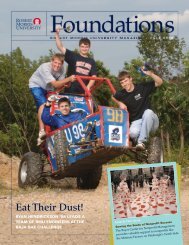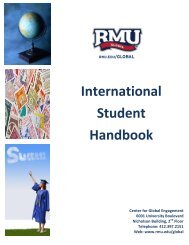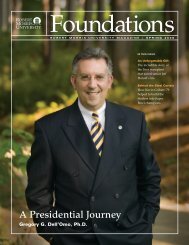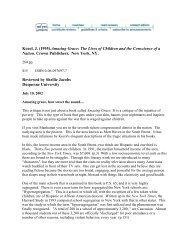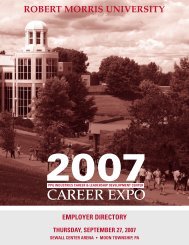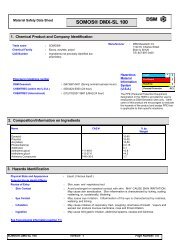Spring 2007 - Robert Morris University
Spring 2007 - Robert Morris University
Spring 2007 - Robert Morris University
- No tags were found...
Create successful ePaper yourself
Turn your PDF publications into a flip-book with our unique Google optimized e-Paper software.
KEEPING BUSY<br />
Life at the observatory is measured in 15-minute intervals,<br />
and Metcalf had to learn quickly how to perform tasks<br />
such as operating the station’s weather instruments, making<br />
repairs to expensive equipment in extreme conditions and<br />
double-checking weather data.<br />
A typical day starts at 5 a.m. with a quick breakfast.<br />
Metcalf often ventures outside twice before 6:30 – once for<br />
an observation and again to collect the precipitation can.<br />
The observations are at the core of the station’s mission.<br />
“A lot of stations will have computers telling you what the<br />
temperature is, and maybe they use radar and infrared to<br />
gauge cloud thickness,” he says. “We are unique because we<br />
have people up here 24 hours a day, 365 days a year. It adds<br />
a human element; we can describe what we’ve seen with<br />
our own eyes.”<br />
After his excursions, Metcalf spends some time verifying<br />
the previous day’s data. The staff tries to triple-check all of<br />
the data it compiles: Yesterday’s scribbled observations are<br />
copied over neatly onto clean forms, and the results are sent<br />
to a national weather database. The rest of the morning is<br />
a blur of paperwork, on-the-fly weather forecasting, an<br />
observation or three, and maybe a live radio broadcast. He<br />
also makes a trip to the upper part of the observation tower<br />
to change an air filter for a <strong>University</strong> of New Hampshire<br />
air quality study he’s helping to conduct.<br />
In the afternoon, Metcalf has some time to work on his<br />
own projects. Part of his internship involves making several<br />
documentary-style videos about the observatory, so he<br />
spends a lot of time running around, camcorder in hand.<br />
Between observations, he edits video, crunches data and<br />
leads educational tours through the observatory. After<br />
16 hours of nonstop activity comes bedtime, but the low<br />
oxygen levels make sleep fitful. To keep up this hard-driving<br />
schedule, the observatory crew breaks into two shifts, which<br />
rotate on and off duty each Wednesday.<br />
That’s the routine. Then there’s the unexpected.<br />
RESPECTING THE MOUNTAIN<br />
In mid-April, a Nor’easter rolled across much of the northern<br />
U.S. and slammed into Mt. Washington. The wind hit 156<br />
miles per hour, equivalent to a Category 5 hurricane, and<br />
the storm dumped two feet of snow on the mountain. A<br />
glaze of ice built up on everything at a rate of 5 to 6 inches<br />
an hour. The combination of ice, snow and wind smashed<br />
instruments, snapped steel anchoring cables and blocked the<br />
observatory’s entrance with a 7-foot snow drift. It took more<br />
than three days for the crew to restore basic functionalities.<br />
Even in less extreme circumstances, the crew stays on its<br />
guard. “We respect the mountain, and we never take it for<br />
granted,” Metcalf says. “It can be quite deadly.” The slopes<br />
of Mt. Washington have claimed 150 people in the last<br />
century – comparable to the number of climbers who<br />
have died on Mt. Everest in the same timeframe.<br />
The high winds are one factor. At 50 miles an hour, which<br />
is pretty low for the summit, you have to lean into the<br />
wind to walk, Metcalf explains. At 75 miles an hour, Metcalf<br />
has to brace himself just to stand. Movement requires leaning<br />
into the wind at a 45-degree angle and carefully executing<br />
each step. At 100 miles an hour, just standing up becomes<br />
nearly impossible.<br />
Extreme temperatures are another danger. Wind chills<br />
of minus 80 F are not uncommon, and frostbite can set in<br />
quickly. In January, Metcalf suffered severe frostbite near<br />
his left eye after accidentally leaving a gap between his<br />
goggles and face mask. He was outside for 10 minutes.<br />
Falling ice is also a concern. Once Metcalf was making<br />
some cloud observations when he felt a shearing pain in<br />
his shoulder. A block of ice had narrowly missed his head.<br />
THRILLS AND BEAUTY<br />
Despite the dangers, Metcalf has embraced life on the<br />
mountain. During breaks in the weather, he grabs his<br />
video camera hoping to catch a fiery sunset or rare cloud<br />
formation. The stars are brighter and more numerous from<br />
the peak, and on a clear day, he can see the Atlantic Ocean.<br />
The beauty and solitude is refreshing, he says.<br />
There isn’t much to do at the observatory besides work, so the<br />
crew has several stunts and games they’ll attempt, conditions<br />
permitting. One is the “Superman,” where a crew member<br />
holds on to a stationary object and allows the wind to lift his<br />
or her body to a horizontal position. There’s cardboard box<br />
sailing, where they hop into cardboard boxes while the wind<br />
pushes them across the ice-covered observation deck. But<br />
the feat every visitor to Mt. Washington aspires to is joining<br />
the Century Club.<br />
The Century Club is an elite group of 15 or so who have<br />
managed to walk the perimeter of the observation deck in<br />
sustained 100-mile-an-hour winds without falling down or<br />
18 • WWW.RMU.EDU





